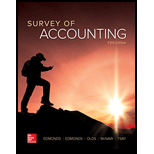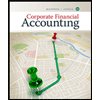
Survey Of Accounting
5th Edition
ISBN: 9781259631122
Author: Edmonds, Thomas P.
Publisher: Mcgraw-hill Education,
expand_more
expand_more
format_list_bulleted
Concept explainers
Textbook Question
Chapter 3, Problem 22P
Problem 4-23A Identifying freight costs
Required
For each of the following events, determine the amount of freight paid by The Box Company. Also indicate whether the freight cost would be classified as a product or period (selling and administrative) cost.
- a. Purchased merchandise with freight costs of $650. The merchandise was shipped FOB shipping point.
- b. Shipped merchandise to customers, freight terms FOB shipping point. The freight costs were $310.
- c. Purchased inventory with freight costs of $1,500. The goods were shipped FOB destination.
- d. Sold merchandise to a customer. Freight costs were $520. The goods were shipped FOB destination.
Expert Solution & Answer
Want to see the full answer?
Check out a sample textbook solution
Students have asked these similar questions
I want to correct answer general accounting
Want to this question answer general Accounting
Quick answer of this accounting questions
Chapter 3 Solutions
Survey Of Accounting
Ch. 3 - 1. Define merchandise inventory. What types of...Ch. 3 - 2. What is the difference between a product cost...Ch. 3 - 3. How is the cost of goods available for sale...Ch. 3 - 4. What portion of cost of goods available for...Ch. 3 - 5. When are period costs expensed? When are...Ch. 3 - 6. If PetCo had net sales of 600,000, goods...Ch. 3 - Prob. 7QCh. 3 - 8. What are the effects of the following types of...Ch. 3 - 9. Northern Merchandising Company sold inventory...Ch. 3 - 10. If goods are shipped FOB shipping point, which...
Ch. 3 - 11. Define transportation-in. Is it a product or a...Ch. 3 - Prob. 12QCh. 3 - Prob. 13QCh. 3 - 14. Dyer Department Store purchased goods with the...Ch. 3 - 15. Eastern Discount Stores incurred a 5,000 cash...Ch. 3 - 16. What is the purpose of giving credit terms to...Ch. 3 - Prob. 17QCh. 3 - 18. Ball Co. purchased inventory with a list price...Ch. 3 - 22. Explain the difference between purchase...Ch. 3 - Prob. 20QCh. 3 - Prob. 21QCh. 3 - 25. What is the advantage of using common size...Ch. 3 - 27. What is the purpose of preparing a schedule of...Ch. 3 - 28. Explain how the periodic inventory system...Ch. 3 - Prob. 25QCh. 3 - Exercise 3-1 Determining the cost of financing...Ch. 3 - Exercise 3-2 Comparing a merchandising company...Ch. 3 - Exercise 3-3 Effect of inventory transactions on...Ch. 3 - Exercise 3-4 Effect of inventory transactions on...Ch. 3 - Exercise 3-5 Recording inventory transactions in a...Ch. 3 - Exercise 4-6A Understanding the freight terms FOB...Ch. 3 - Exercise 3-7 Effect of purchase returns and...Ch. 3 - Exercise 3-8 Accounting for product costs:...Ch. 3 - Effect of product cost and period cost: Horizontal...Ch. 3 - Cash Discounts and Purchase Returns On April 6,...Ch. 3 - Exercise 4-9A Determining the effect of inventory...Ch. 3 - Inventory financing costs Bill Norman comes to you...Ch. 3 - Effect of shrinkage: Perpetual system Ho Designs...Ch. 3 - Comparing gross margin and gain on sale of land...Ch. 3 - Single-step and multistep income statements The...Ch. 3 - Prob. 16ECh. 3 - Effect of cash discounts on financial statements:...Ch. 3 - Using common size statements and ratios to make...Ch. 3 - Prob. 19ECh. 3 - Determining cost of goods sold: Periodic system...Ch. 3 - Identifying product and period costs Required...Ch. 3 - Problem 4-23A Identifying freight costs Required...Ch. 3 - Effect of purchase returns and allowances and...Ch. 3 - Preparing a schedule of cost of goods sold and...Ch. 3 - Prob. 25PCh. 3 - Comprehensive cycle problem: Perpetual system At...Ch. 3 - Prob. 27PCh. 3 - Comprehensive cycle problem: Periodic system...Ch. 3 - Prob. 1ATCCh. 3 - ATC 3-2 Group Exercise Multistep income statement...Ch. 3 - Prob. 3ATCCh. 3 - Prob. 4ATC
Knowledge Booster
Learn more about
Need a deep-dive on the concept behind this application? Look no further. Learn more about this topic, accounting and related others by exploring similar questions and additional content below.Similar questions
arrow_back_ios
SEE MORE QUESTIONS
arrow_forward_ios
Recommended textbooks for you
 Financial Accounting: The Impact on Decision Make...AccountingISBN:9781305654174Author:Gary A. Porter, Curtis L. NortonPublisher:Cengage Learning
Financial Accounting: The Impact on Decision Make...AccountingISBN:9781305654174Author:Gary A. Porter, Curtis L. NortonPublisher:Cengage Learning Cornerstones of Financial AccountingAccountingISBN:9781337690881Author:Jay Rich, Jeff JonesPublisher:Cengage LearningPrinciples of Accounting Volume 1AccountingISBN:9781947172685Author:OpenStaxPublisher:OpenStax College
Cornerstones of Financial AccountingAccountingISBN:9781337690881Author:Jay Rich, Jeff JonesPublisher:Cengage LearningPrinciples of Accounting Volume 1AccountingISBN:9781947172685Author:OpenStaxPublisher:OpenStax College Corporate Financial AccountingAccountingISBN:9781305653535Author:Carl Warren, James M. Reeve, Jonathan DuchacPublisher:Cengage Learning
Corporate Financial AccountingAccountingISBN:9781305653535Author:Carl Warren, James M. Reeve, Jonathan DuchacPublisher:Cengage Learning Corporate Financial AccountingAccountingISBN:9781337398169Author:Carl Warren, Jeff JonesPublisher:Cengage Learning
Corporate Financial AccountingAccountingISBN:9781337398169Author:Carl Warren, Jeff JonesPublisher:Cengage Learning Financial & Managerial AccountingAccountingISBN:9781337119207Author:Carl Warren, James M. Reeve, Jonathan DuchacPublisher:Cengage Learning
Financial & Managerial AccountingAccountingISBN:9781337119207Author:Carl Warren, James M. Reeve, Jonathan DuchacPublisher:Cengage Learning

Financial Accounting: The Impact on Decision Make...
Accounting
ISBN:9781305654174
Author:Gary A. Porter, Curtis L. Norton
Publisher:Cengage Learning

Cornerstones of Financial Accounting
Accounting
ISBN:9781337690881
Author:Jay Rich, Jeff Jones
Publisher:Cengage Learning

Principles of Accounting Volume 1
Accounting
ISBN:9781947172685
Author:OpenStax
Publisher:OpenStax College

Corporate Financial Accounting
Accounting
ISBN:9781305653535
Author:Carl Warren, James M. Reeve, Jonathan Duchac
Publisher:Cengage Learning

Corporate Financial Accounting
Accounting
ISBN:9781337398169
Author:Carl Warren, Jeff Jones
Publisher:Cengage Learning

Financial & Managerial Accounting
Accounting
ISBN:9781337119207
Author:Carl Warren, James M. Reeve, Jonathan Duchac
Publisher:Cengage Learning
Chapter 6 Merchandise Inventory; Author: Vicki Stewart;https://www.youtube.com/watch?v=DnrcQLD2yKU;License: Standard YouTube License, CC-BY
Accounting for Merchandising Operations Recording Purchases of Merchandise; Author: Socrat Ghadban;https://www.youtube.com/watch?v=iQp5UoYpG20;License: Standard Youtube License